The Live Cell RNA Detection Market is estimated to be valued at USD 3.4 billion in 2025 and is projected to reach USD 7.5 billion by 2035, registering a compound annual growth rate (CAGR) of 8.4% over the forecast period.
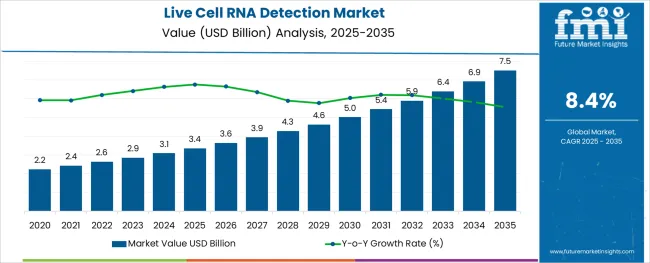
The live cell RNA detection market is experiencing consistent growth, supported by rising demand for real-time gene expression analysis in cellular environments. Increasing emphasis on non-destructive, high-resolution molecular biology techniques has led to advancements in RNA imaging technologies that allow visualization within living cells without compromising cell viability. The convergence of genomics, bioinformatics, and microscopy is enabling dynamic monitoring of RNA behavior, crucial for studying diseases, drug responses, and developmental biology.
Accelerated adoption of RNA-based therapeutics and companion diagnostics is further elevating the need for precise intracellular RNA detection tools. Biotech companies and research institutions are leading investments in platform development, leveraging nanotechnology and fluorescence-based hybridization probes.
Regulatory encouragement of RNA-targeted diagnostics, combined with rising academic and commercial research funding, is opening new avenues. As single-cell analysis and personalized medicine continue to expand, demand for live RNA detection systems is expected to increase across both preclinical and clinical research workflows.
The market is segmented by Techniques, Application, and End User and region. By Techniques, the market is divided into Linear Oligonucleotide Probe, Linear FRET Probe, Autoligation FRET Probe, Molecular Beacon, MS2-GFP, Bgl-mCherry, lN-GFP, PUM-HD, and Spinach RNA Tracking System. In terms of Application, the market is classified into Diagnostics, Research and Development, and Drug Discovery.
Based on End User, the market is segmented into Biotechnology Companies, Academic Institutes, and Clinical Research Organizations. Regionally, the market is classified into North America, Latin America, Western Europe, Eastern Europe, Balkan & Baltic Countries, Russia & Belarus, Central Asia, East Asia, South Asia & Pacific, and the Middle East & Africa.
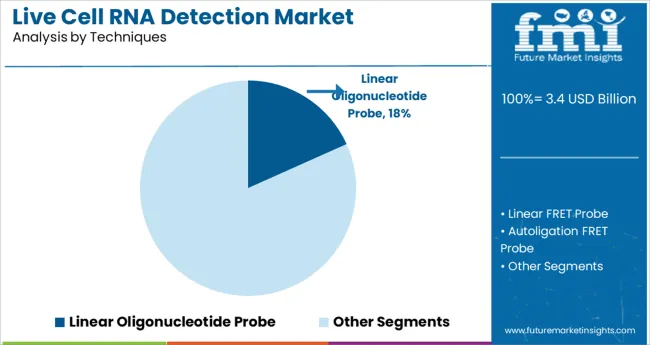
Linear oligonucleotide probes are projected to capture 18.3% of the total revenue in 2025 under the techniques segment. Their growth is attributed to the simplicity of design, rapid hybridization kinetics, and cost-effectiveness when compared to complex structured probes.
These probes enable effective detection of specific RNA sequences within living cells while maintaining cellular integrity. Their minimal secondary structure reduces background noise, making them highly suitable for quantitative live-cell imaging.
The compatibility of linear oligonucleotide probes with fluorescence-based detection systems and ease of chemical modification for target specificity are additional drivers supporting their increased use. Research communities have favored these probes for gene expression tracking and target validation studies, contributing to their expanding footprint in academic, clinical, and commercial settings.
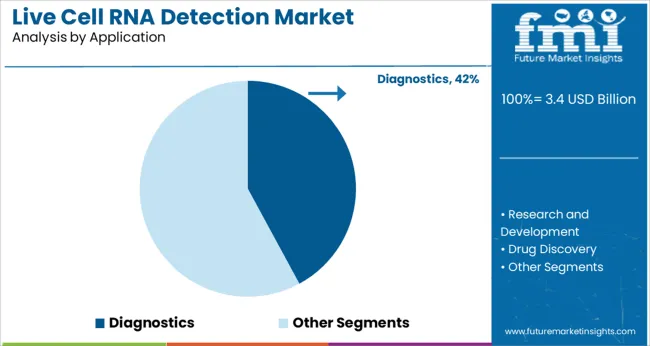
The diagnostics segment is anticipated to command 42.1% of the live cell RNA detection market revenue in 2025, making it the leading application. This growth is being fueled by the rising adoption of RNA-based diagnostic platforms for early disease detection, especially in oncology, infectious disease monitoring, and neurological disorders.
Live cell RNA detection techniques are enabling real-time observation of RNA biomarkers, facilitating the identification of dynamic cellular changes before phenotypic manifestations. Their application in point-of-care diagnostics and personalized medicine has seen significant momentum due to the precision and speed they offer.
As regulatory bodies emphasize early screening and molecular precision diagnostics, the clinical utility of live RNA detection methods continues to rise, driving further innovation and integration into diagnostic workflows across hospitals and specialized labs.
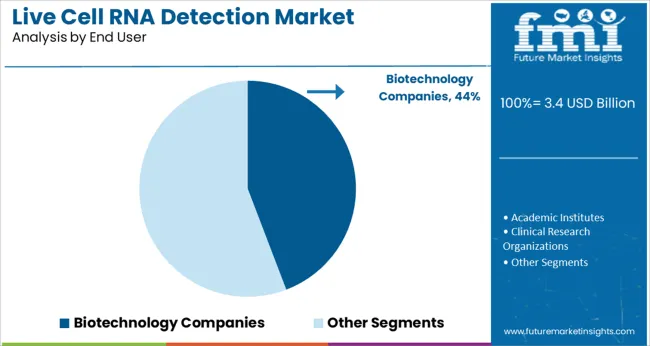
Biotechnology companies are forecast to hold 44.2% of market revenue in 2025, positioning them as the dominant end user in the live cell RNA detection landscape. Their leadership stems from strong investment in RNA-targeted research, therapeutic development, and in-house diagnostic tool creation.
These companies are at the forefront of adopting next-generation imaging technologies to support cell-based assays, drug development, and gene therapy platforms. The demand for highly sensitive and real-time detection systems in preclinical validation and target screening has further accelerated platform integration across biotech pipelines.
Strategic collaborations with academic institutions and healthcare organizations are also enabling biotech firms to expand the application of live RNA detection into translational research. With ongoing advancements in mRNA-based therapies and precision medicine, biotechnology companies are expected to maintain their leadership role in shaping the commercial direction of this market.
The increasing research and development activities in molecular diagnostics sector and increasing availability of various new methodology and techniques are the major factors that are expected to boost the growth of the live cell RNA detection market during the forecast period.
Factors such as the increasing applications of RNA detection techniques in the genetic disorder detection and the increasing prevalence of cancer diseases are expected to propel the growth of the live cell RNA detection market over the analysis period.
The advantages of live cell RNA detection over the conventional techniques as conventional techniques failed to provide important spatial, temporal information, also anticipated to propel the demand for the live cell RNA detection and boost the growth of the global live cell RNA detection market over the forecast period. The funding by the various regulatory bodies and governments also expected to bolster the growth of the global live cell RNA detection market.
The high cost of reagents and devices required for live cell RNA detection is one of the major factors that is expected to hinder the growth of the live cell RNA detection market during the forecast period.
In addition, the stringent rules and regulatory guidance by the USA Food and Drug Administration (FDA), may also hinder the growth of the global live cell RNA detection market.
Moreover, the lack of skilled personnel to perform the detection, and high-content screening systems are also expected to impede the growth of the global live cell RNA detection market during the analysis period.
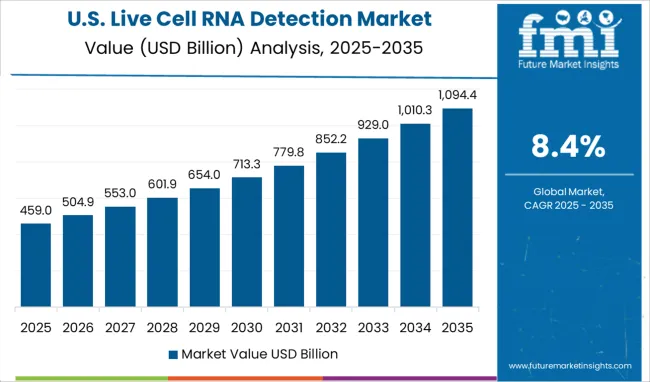
In terms of regional platform, North America holds the largest market share in Live Cell RNA Detection market. The region is expected to surge at over 35.0% share from 2025 to 2035.
North America is expected to fuel the Live Cell RNA Detection market, attributed to the developed laboratory infrastructure and availability of skilled personnel in the region.
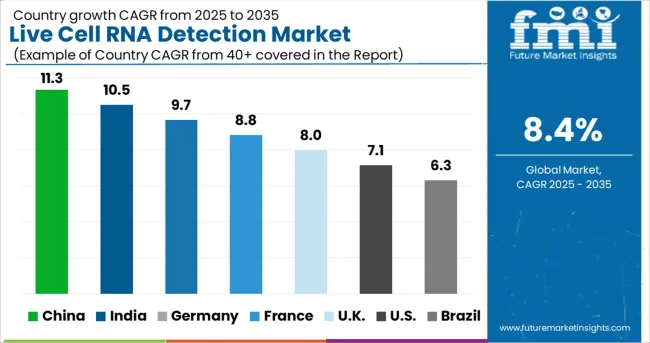
According to Future Market Insights, Europe is expected to hold significant growth opportunities for Live Cell RNA Detection, and is expected to reach at a share of 29.0% in 2025.
Europe is expected to witness a significant market growth, owing to the increasing research and development activities along with government support and funding in the region.
According to Future Market Insights, Asia-Pacific is expected to grow with lucrative growth opportunities for Live Cell RNA Detection Market, and is expected to reach at a significant share of 20.3% in 2025.
Asia-Pacific region accounts for a significant share in Live Cell RNA Detection Market, attributed to the factors such as the government initiatives for research on stem cell therapy, the rising prominence of regenerative medicine research, growth of preclinical/clinical research in China, favorable changes in foreign direct investment (FDI) regulations in the pharmaceutical industry in India, and growth of the pharmaceutical and biopharmaceutical sectors in South Korea.
According to Future Market Insights, Middle East & Africa is expected to provide significant growth opportunities for Live Cell RNA Detection Market, and is expected to reach at a share of 10.3% in 2025.
The developing Live Cell RNA Detection market in the Middle East & Africa is expected to aid in flourishing market during the forecast period, owing to increasing awareness about Live Cell RNA Detection in the region.
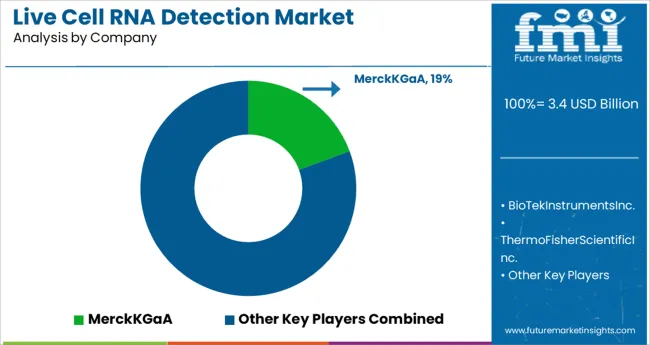
There are many prominent market players in the Live Cell RNA Detection Market such as CytoSMART Technologies, INNOMED GmbH, Algorithmic Biologics, Phiab, uFluidix, JPK Instruments AG, and Tzar Labs, among others, that are working hand-in-hand to provide the best-in-class Live Cell RNA Detection for enhancing the global arena. However, there are many global start-ups in the Live Cell RNA Detection Market, that are stepping forward in matching the requirements of the Live Cell RNA Detection domain.
Some of the key participants present in the global Live Cell RNA Detection market include Merck KGaA, BioTek Instruments, Inc., Thermo Fisher Scientific, Inc., Agilent Technologies Inc., MilliporeSigma, Promega Corporation, Biomol GmbH, Advanced Cell Diagnostics, Inc. and Qiagen Diagnostics, Nikon, and Bruker Corporation, among others.
Attributed to the presence of such high number of participants, the market is highly competitive. While global players such as Merck KGaA, BioTek Instruments, Inc., Thermo Fisher Scientific, Inc., Agilent Technologies Inc., and MilliporeSigma account for a considerable market size, several regional level players are also operating across key growth regions, particularly in North America.
| Report Attribute | Details |
|---|---|
| Growth Rate | CAGR of 8.4% from 2025 to 2035 |
| Market Value in 2025 | USD 2,631.8 Million |
| Market Value in 2035 | USD 6,404.2 Million |
| Base Year for Estimation | 2024 |
| Historical Data | 2020-2024 |
| Forecast Period | 2025-2035 |
| Quantitative Units | Revenue in USD Million and CAGR from 2025-2035 |
| Report Coverage | Revenue Forecast, Volume Forecast, Company Ranking, Competitive Landscape, Growth Factors, Trends and Pricing Analysis |
| Segments Covered | North America, Latin America, Europe, Asia Pacific, Middle East and Africa |
| Regions Covered | North America; Latin America; Europe; Asia Pacific; Middle East and Africa |
| Key Countries Profiled | USA, Canada, Brazil, Argentina, Germany, UK, France, Spain, Italy, Nordics, Belgium, Netherlands, Luxembourg, Poland, Russia, Australia & New Zealand, China, India, ASEAN, GCC, South Africa |
| Key Companies Profiled | Merck KGaA; BioTek Instruments, Inc.; Thermo Fisher Scientific, Inc.; Agilent Technologies Inc.; MilliporeSigma; Promega Corporation; Biomol GmbH; Advanced Cell Diagnostics, Inc. and Qiagen Diagnostics; Nikon; and Bruker Corporation; among others. |
| Customization | Available Upon Request |
The global live cell rna detection market is estimated to be valued at USD 3.4 billion in 2025.
It is projected to reach USD 7.5 billion by 2035.
The market is expected to grow at a 8.4% CAGR between 2025 and 2035.
The key product types are linear oligonucleotide probe, linear fret probe, autoligation fret probe, molecular beacon, ms2-gfp, bgl-mcherry, ln-gfp, pum-hd and spinach rna tracking system.
diagnostics segment is expected to dominate with a 42.1% industry share in 2025.






Full Research Suite comprises of:
Market outlook & trends analysis
Interviews & case studies
Strategic recommendations
Vendor profiles & capabilities analysis
5-year forecasts
8 regions and 60+ country-level data splits
Market segment data splits
12 months of continuous data updates
DELIVERED AS:
PDF EXCEL ONLINE
Liver Disease Diagnostics Market Size and Share Forecast Outlook 2025 to 2035
Liver Cancer Diagnostics Market Size and Share Forecast Outlook 2025 to 2035
Live Seafood Market Size and Share Forecast Outlook 2025 to 2035
Livestock Panel Gates Market Size and Share Forecast Outlook 2025 to 2035
Livestock Trailer Market Size and Share Forecast Outlook 2025 to 2035
Liver Health Supplements Market Analysis - Size, Growth, and Forecast 2025 to 2035
The Liver Transplantation Market is segmented by Treatment type and End User from 2025 to 2035
Liver Fibrosis Treatment Market - Innovations & Future Trends 2025 to 2035
Global Live Stock Vaccine Market Analysis – Size, Share & Forecast 2024-2034
Liver Fluke Treatment Market
Live Vaccines Market
Livestock Monitoring System Market
Live Cell Encapsulation Market Analysis & Forecast for 2025 to 2035
Olive Market Size and Share Forecast Outlook 2025 to 2035
Olive Oil Market Size and Share Forecast Outlook 2025 to 2035
Olive and Olive Derivatives Market – Growth, Demand & Industry Insights
Olive Leaf Extract Market
Delivery Management Software Market Size and Share Forecast Outlook 2025 to 2035
Delivery Tracking Platform Market Size and Share Forecast Outlook 2025 to 2035
Wire Livestock Panels Market Size and Share Forecast Outlook 2025 to 2035

Thank you!
You will receive an email from our Business Development Manager. Please be sure to check your SPAM/JUNK folder too.
Chat With
MaRIA